Bennettswood Primary School
Primary School Teachers 1950s
14 12 16 16:22 Filed in: Children 1950s
MARGARET
Like everyone else I started school in “Bubs”, aged five. The baby boom was in full swing and there must have been an imbalance of kids between my year and the next because one day, out of the blue, the woman in charge of the little kids, (called the “Head Mistress” *snigger*) came into our class and called out half a dozen names including mine. We duly stood and followed her into the class next door: Miss Meadow’s Grade One, making a total of 47 little baby boomers in her class. I had already been through the joys of John and Betty, so the move might have been mid year. I loved Miss Meadows, it can’t have been too traumatic.
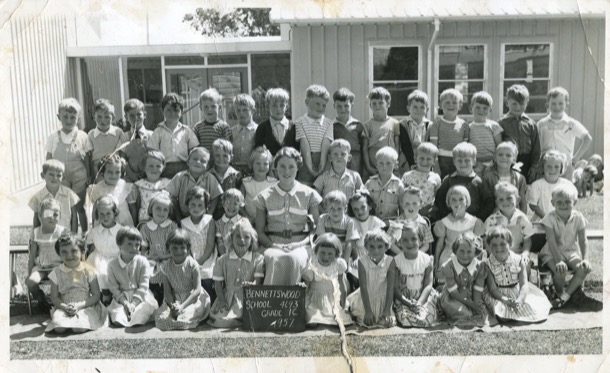
My only other specific memory from those very early years was the Junior Mistress with a dressed up visitor accosting me in the playground and asking me what half of eleven was. I was very aware that I was part of a little show to impress the lady, and I remember consciously acting out the part of the clever but deferential little student.
In Grade four, we had monthly tests, probably in Reading, Composition, Spelling, Arithmetic, Writing, maybe some sort of social studies…. a variety of things. The results were compiled into a single numerical score. Each month the class’s seating would be rearranged into numerical order according to these results. The top two sat in the back desk in the furthest left hand row, the bottom two in the front desk in the furthest right hand row. There were four of us who vied each month for that top spot. So I shared a desk with Gordon, Dianne or Wayne. And when Mr Symes left the room, he left me, Gordon, Dianne or Wayne in charge. It was Mr Symes who told me that I needed to hold my pen properly for writing, or else I wouldn’t be able to take notes properly at university… no pressure Margaret! I remember him as kindly and firm but not cruel.
Mr Woods on the other hand, my Grade three teacher, was scarily unpredictable. He had been a soldier and probably had terrible PTSD. He used the strap liberally and publicly against girls and boys. Once a couple of boys got the giggles during the Last Post bugle call at an Anzac Day assembly. As we filed back into class we all knew the signs… someone was in for it. He stood the boys up in the front of the class and whacked the strap across their bare legs, punctuating the whacks with a diatribe, the content of which I don’t remember.
At other times I remember him offering kids the choice of a hundred words or the strap and randomly dishing out the punishment they chose, or the one they didn’t choose. You never knew which would happen. I have no memory of his teaching or my learning… only the terrifying punishments and unpredictable outbursts.
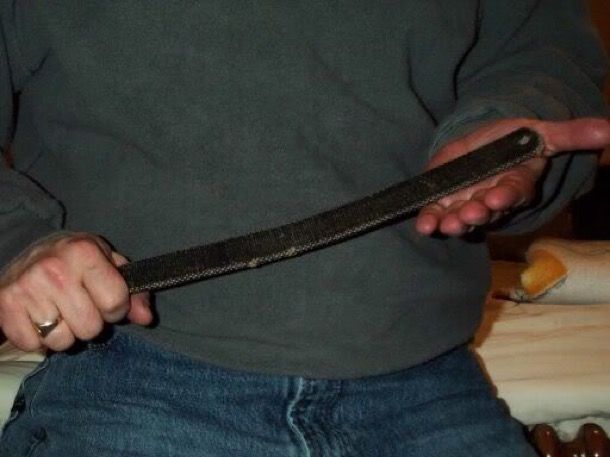
My Grade five teacher was Mr O’Brien, an older man: competent, kind, musical, enthusiastic. The weekly spelling list became cryptic puzzles for those who finished their work ahead of the rest. There was a piano in the corner of the room and we sang often. He was a keen gardener and the whole class made geranium cuttings in the front garden. I often missed out on these extra activities because I was the designated “helper” for Joseph. Joseph was so old that he shaved. He had been in grade five for some time. I think this might have been his last year at school. I helped him with his rudimentary literacy and numeracy skills while the other kids were learning about sirex wasps or coal gas or the Spanish Armada.
Mr O’Brien organised the “school concert” and ran the choir. Kids were invited to audition for the concert and Margaret Lees and I prepared a special duet. We sang an English folk song about a cuckoo, as a round. I remember practising round the side of the building. We began with “Oh look, there’s a cuckoo”, “I love cuckoos”… leading ever so seamlessly into the song. But how to finish? Ah of course…. another friend called from “off stage” and we had to run off home for tea. We weren’t asked to repeat our performance at the concert.
My memories of Mr Stafford’s Grade Six are less clearly defined than Sue’s who had him for two years. There was a Speech Error jar on the shelf above the blackboard. If a child said “I seen” or “he done”, their name was put on a slip of paper in the jar. I don’t remember the sanction for this if there was one, as it never involved me, needless to say.
SUE
I have few memories of my Box Hill South Primary teachers. I vividly remember starting Prep or Bubs as it was known then. I remember learning to write with a big thick grey lead pencil, reading from John and Betty , the innumerable flash cards beginning with words, phrases and then sentences all based on John and Betty.
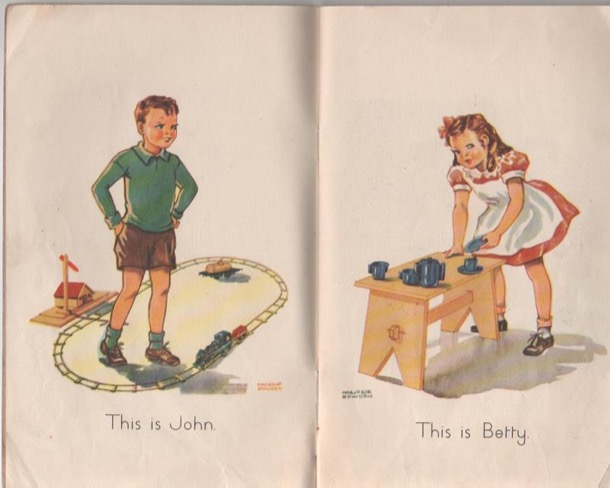
Of Grade One I only have memories of the large picture hats the Head Mistress wore. I remember it as an everyday occurrence and that they were covered in large flowers. I cant imagine that this was so, maybe she wore one once. As her office was right next to our room we would have seen Miss Shattock often as she went about her important duties.
Grade Two, on the other hand, I do remember but, again, not the teacher. The room was upstairs in the old section of the school, each room had a large fireplace in the corner attended to by the boys who, of course, were the wood monitors. The boys feature in my memories of Grade Two, as this was the year I was dared to run into the boys toilet, which I did. A flash in and out, adrenaline pumping, I cannot even remember what I saw in that mysterious place. Another activity I knew occurred on the red brick wall of the boys’ toilet was a peeing competition, never witnessed but obviously talked about. Miss Shattock appeared in my Grade Two classroom the day of my great shame and indignation. I was sitting up the back and was playing a game with the girl over the aisle. We would drop something, both bend down to pick it up and giggle and talk. Down the long aisle (the classes were huge) swept Miss Shattock and marched me to the front of the class to hold out my hand for a smack with the ruler. I was then instructed to stand in the corner until lunchtime. Oh the indignation, outrage and humiliation! At lunchtime surrounded by a bevy of sympathetic girls, I announced to the world that I was going home. I didn't of course and I probably didn't play that little game again either!
In Grade Three I moved to Bennettswood Primary the year Margaret started school too. Miss Burlock, my Grade Three teacher, was a tall redhead. She wore black straight skirts that she teamed with pale stockings through which we glimpsed her freckled legs. She probably had nice legs and showed them off with very high heels. I didn't like her much, especially as she made me feel embarrassed when spelling potatoes out loud to the whole class. I pronounced it pot a toes, spelt it correctly, but was sharply corrected for my mispronunciation.
Grade Four and I loved Mr Norman. We moved across the quadrangle and I had a wonderful time in his class. He was an interesting teacher who frequently read aloud to us. He did this very well, obviously enjoying it. I do remember having a sore stomach from so much laughing when he read us the Henry Lawson story, The Loaded Dog. We also did lots of projects on a wide variety of topics.
I loved school but I particularly loved Mr Stafford’s Grade 5 and 6 classes. He must have been a very good teacher. He was very old of course, at least 40. He lived near us in Byron Street and we sometimes saw him walking home from the bus in his check sports coat, leather case in hand.
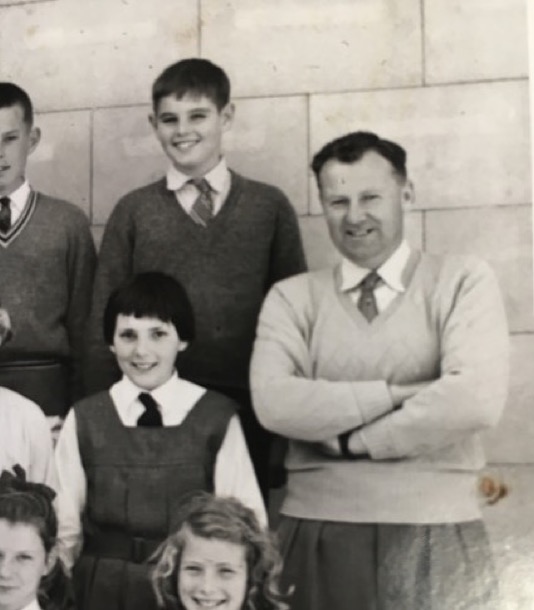
An important aspect of Grade 6 was Temperance Physiology and the signing of The Pledge. It seemed as if every morning began with:
‘Our bodies are made of millions of tiny cells………..’ This was the first sentence in our Temperance Physiology exercise book. Mr Stafford was a staunch teetotaller. We knew for instance that not a drop of alcohol had ever passed his lips, so he would have been very much in favour of teaching from the book, Temperance for Schools, approved for use by Victorian Education Department.
Reading the Preface to this book it seems like something from a distant age. I suppose it was! Suburban, white, mono cultural, Melbourne in the 1950’s

Our Temperance Physiology classes warned us of the evils of alcohol and the dangers that lay in wait for the unwary who indulged. I can remember with great gusto drawing an illustration in my exercise book of a wretched drunken man raising a fist to his cowering wife and children. Embellishments were a broken beer bottle on the ground and a trim policeman standing sternly at the door.
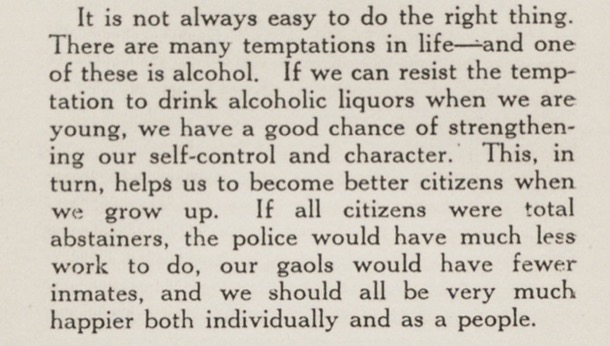
Towards the end of the year we sat for the Temperance Physiology Exam and if we passed it was presumed we were saved and we received a glorious shiny certificate from the Independent Order of the Rechabites.
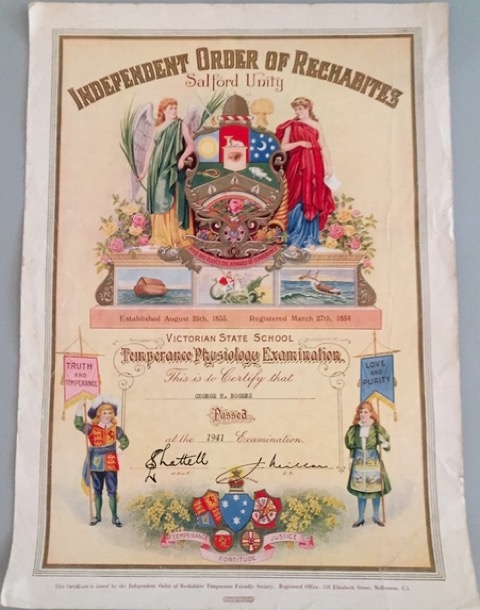
Another highlight was Poetry Anthology. Not only did we copy the poem in our best writhing into our Poetry Anthology book, but we also illustrated each poem. Of course I loved using my Derwent pencils to draw the Lady of Shallot floating down the river golden tresses trailing around her lifeless body. We also recited poems and Margaret and I, to this day, can still recite the first verse of several of the poems learnt in Grade 6, precisely as taught to both of us, (in separate years) by Mr Stafford.
Comments
"Are you up to it?"
26 10 16 15:05 Filed in: Children 1950s
All the kids in the neighbourhood walked to school. It’s what kids have done for ever. We went to Bennettswood State School from 1956, Sue in Grade three, Margaret in Bubs (prep). Our journey took us through neighbourhood streets and lanes, and through a bushland, urban waste area and along and across the Gardiners Creek. This was our usual way to school from then until we each finished High School, Sue in 1966 and me in 1968.
So now, sixty years later, we contemplated walking it again, those same roads and lanes, across that same creek. In our memories it was a long long way. “Are you up to it?”, Margaret texted Sue.
We park outside our old house in Moore Street and set off. And as we walk we remember:
Less than a minute into the walk, we round the corner into Grandview Road. To the west are the Dandenongs. The street trees are large and bright in their early Spring colours. It’s suburban, but well heeled and attractively quiet. We remark on a number of houses that seem unchanged. There’s the house where I babysat once, there’s another one where people from the church lived.
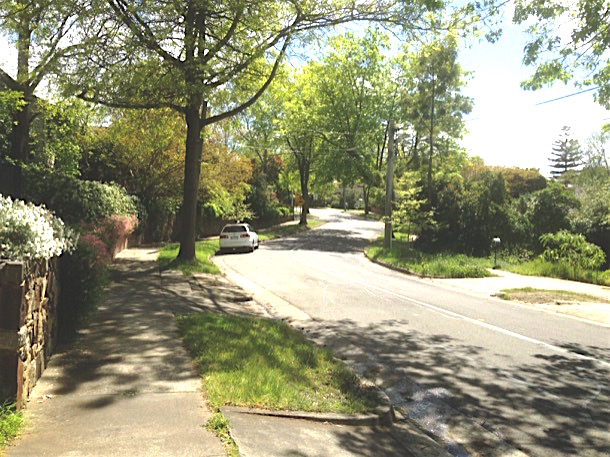
As we did this walk every school day, rain, hail or shine, we developed little rituals and markers, that now sixty years later we remember clearly. We often began our journey down Grandview Road, kicking a stone that we attempted to keep all the way to school. We don't think we ever succeeded.
Bright pink pig face flowers in spring marked the bottom of the hill. If the sun was out we always stopped and stared into the flowers for long enough for the world to turn green when we looked away. of course they are no longer there, but the rockery is.
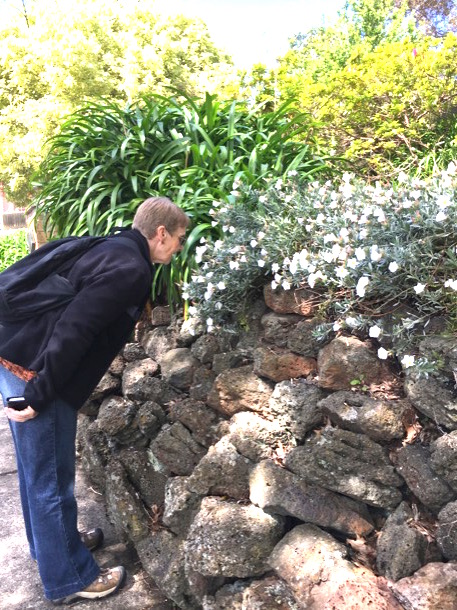
“That’s the street to the Church just there! It’s so tiny! Everything is so close”
We have reached the bottom of Grandview Road in seemingly record time now the distances seem so small.
“I always liked this bit.”
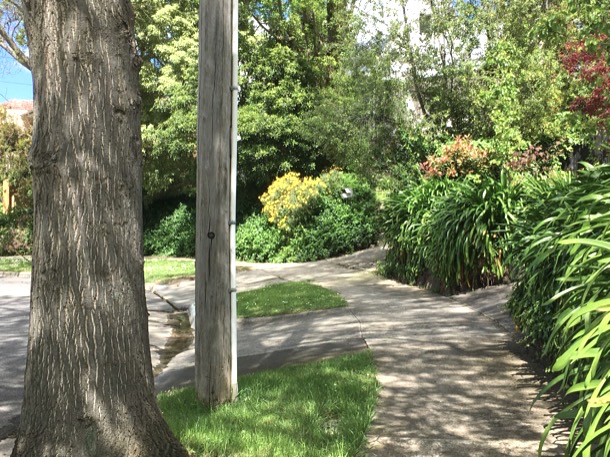
Heading towards Riversdale Road, still in Grandview Road we relive our childhood pleasure in beautiful gardens and leafy streets.
Riversdale Road is quite a major road, but still not too busy. Across from the end of Grandview Road is the entrance to “the lane”.
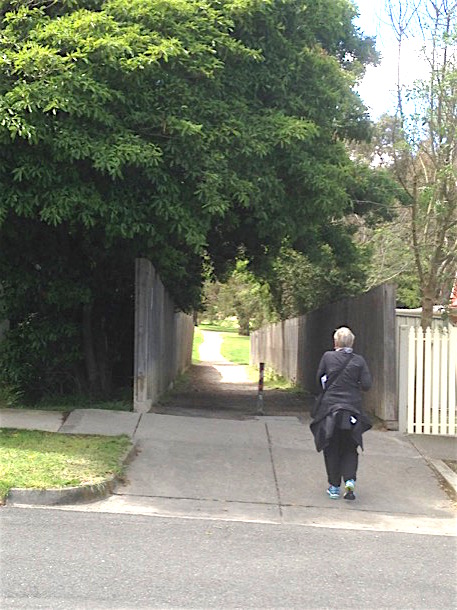
It runs alongside the house that our church minister and family friend lived in. Behind their house were the church tennis courts. That whole property is now a collection of ugly units.The lane continues a long way down the hill toward the creek. At every cross road is an opportunity to go a different way through the grid of streets.
We walk along Neville Street and remark on the difference in this much lower socio economic area. Many of the old public housing houses are still there, unchanged from the nineteen fifties’ building boom. They are noticeable different in style from the “private “ housing and, as children, we knew that they were “housing commission” houses and that they were for poor people.
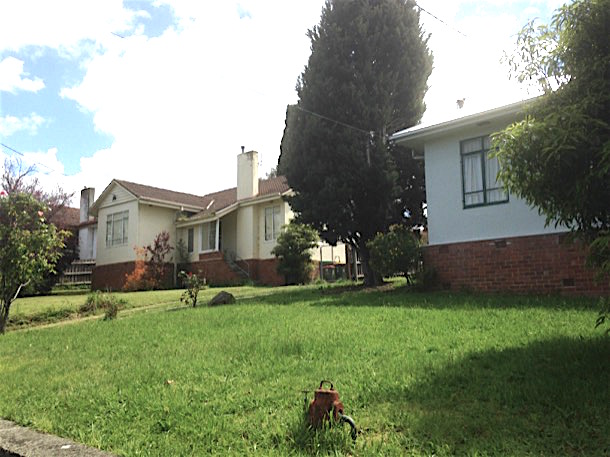
At the bottom of Stott Street we turn into yet another lane and at the other end we emerge into a green oasis.

Dogs are running free, chasing balls and each other, rolling in muddy puddles. Their young owners stand and chat. Up the hill a bit is a natural wood playground: slides, climbing frames, tasteful little forts. Further down the hill is a fenced off area of native bushland and, running through that the Gardiner's Creek. Well tended paths run along both sides of the creek and up to the adjoining streets. A noticeboard has a bird list and information about plans for improvement of the area. It is a pleasant Spring afternoon and Deakin students are strolling or jogging.
We conjure memories of how it was. This, the floodplain of Gardiner's Greek was the ‘wild’ section of the journey. The raised path, built by the fathers of the children who used this track daily, snaked its way across the grassed floodplain towards the bridge, also built by the fathers.
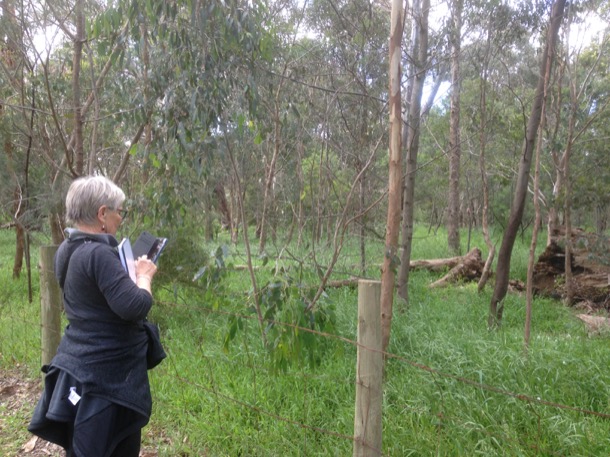
One old River Red-gum marked one of the bends in the path and large clumps of blackberries hid the creek from view. It was not the cherished indigenous community park it is now, but was a neglected wasteland. However it was interesting and often beautiful, especially in the morning. Sometimes we emerged from the lane to a white icy world, where spider webs hung between frosty grass stalks, glistening in the early morning sun. Sometimes the creek flooded. This was very exciting. We walked on the raised pathway, floodwaters on either side, wondering if the bridge was flooded. The water never covered the high bridge but the muddy torrent came very close.

On up the small hill past paling fences that belonged to cream brick houses we emerged on the school oval, the classrooms in the distance. Nowadays it is a multi story carpark.
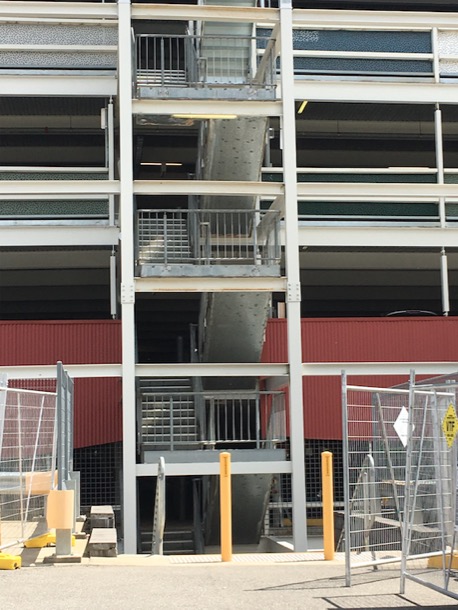
Our little school has been completely swallowed by Deakin University, along with the Teachers College and our secondary school, Burwood High School. We walk onto campus, and there, in the middle of the glamorous uni buildings is a little row of ex classrooms. There on the end is where my Grade four room was, here's the breezeway. Up on the edge is the quadrangle where we practised marching. There was a breezeway along there and Mr Stafford's classroom.
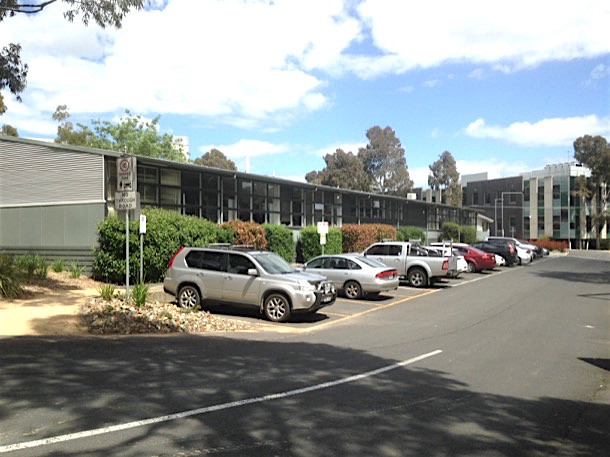
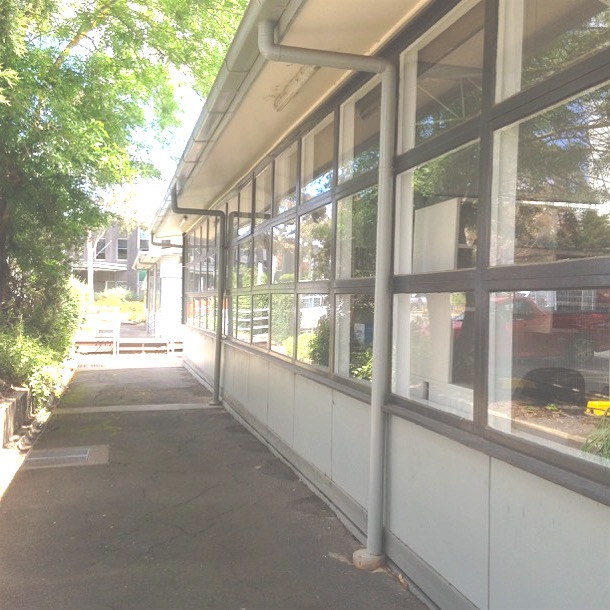
We set off past the car park again, cross the creek and head back into the criss cross of familiar streets.
At the corner of Cadorna and Inverloch Streets we work out the place where “the accident” happened.
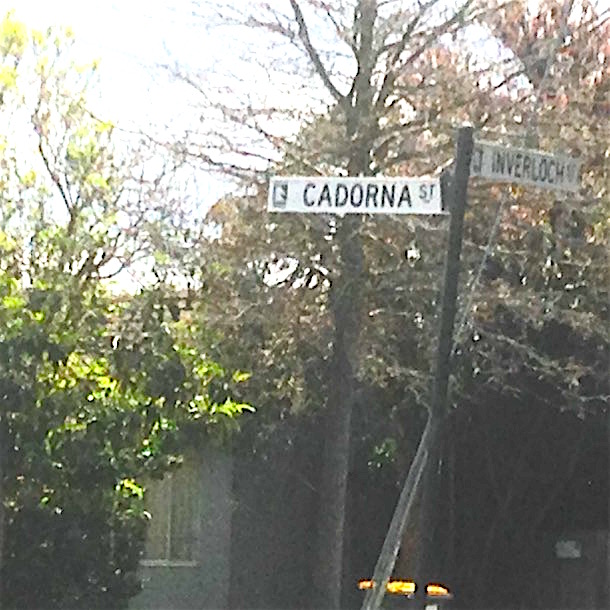
We remember it very differently of course: one of us watched in horror, the other was a participant. Here are our separate memories of it:
Sue:
Summer was a hot and dusty trek back across the creek after a full day at school. Once we had left the creek and started the climb up the hill in the hot suburban streets it was a bit of a slog. One such hot summer afternoon Margaret I were walking home with lan who was in Prep and the usual tribe of kids spread out across the two sides of the road. Margaret, seeing a friend on the other side of the road ran onto the road, straight into the path of an oncoming car. I don't remember much of the accident itself but I do remember a crowd of children and helpful women surrounding us as Margaret lay on the nature strip bloodied and battered with her head on my lap. The distraught young driver of the ute drove to get Mum (no mobiles) while we waited for the ambulance. Margaret disappeared with Mum into the back of an ambulance and Ian and I walked home.
Margaret:
I was nine, in Grade four. We were on the long walk home up the hill. Ian and Sue were there and lots of other kids. I ran across the road without looking, and was hit by a ute driving along Cadorna Street. It was a Friday.
After the accident I lay on the nature strip. “Ladies” from nearby houses tried to cover me with blankets, which I found irritating and pushed away. I remember Mum arriving and the ambulance. From my vantage point in the ambulance I remember seeing the corner of Riverside and Station Streets, as Mum told them they should be turning left not right.
At the Box Hill Hospital, I remember the decision of the doctor to pull out the tooth that was hanging loose. Two other teeth had been knocked right out, both of which had had gold fillings painfully inserted over the previous year, after an accident at gym.
At some stage there was a police interview. I remember Mum describing this process to someone else and laughing about the look on the Policeman’s face as he gently tried to coax information from me only to be presented with a dramatic and colourful description in far more detail than the poor man needed.
I remember coming home later that night. And then, possibly over the weekend, before I went back to school, I got mumps.
People bought presents: colouring books, a white china horse.
I guess the severity of the accident was exaggerated by the fact that I was laid up for weeks with mumps.
The sustained ongoing result of the accident was the absence of my three front teeth. Nowadays there would be counselling, PTSD and expensive restorative dental work.

After the accident reenactment we begin to walk up lnverloch Street. It is long, steep and dull. There are no leafy street trees and interesting gardens. It feels like a concrete jungle. We reminisce about hot afternoons trudging up here lugging our school cases. We turn right at the first cross street, relieved to be able to use the lane instead.
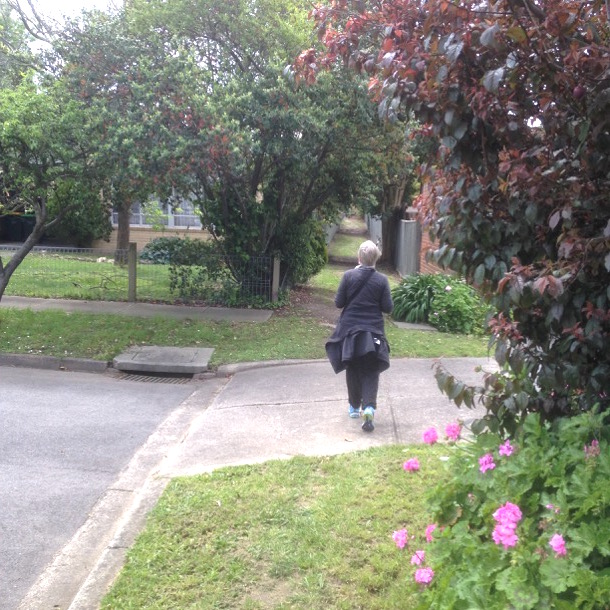
The lane takes us to the same place, the corner of Riversdale and Grandview roads, but it is much less steep. Soon we are crossing Riversdale Road and we remember the leafy cool shade of this part of the journey. It has seemed like a long way and we find ourselves trudging a bit up the hill.
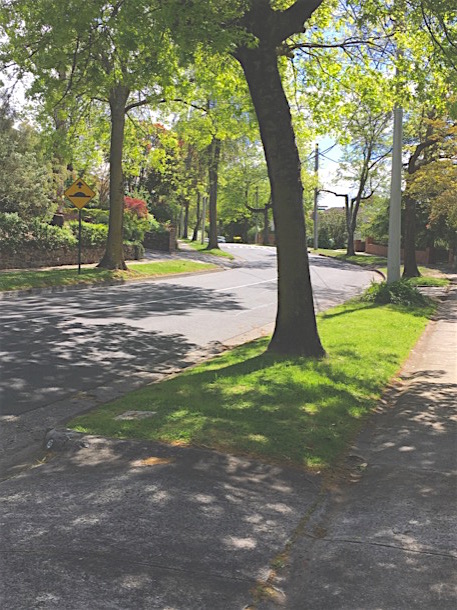
The homeward journey has taken about an hour, including the accident reenactment, stopping to gaze at houses we remember and a conversation with a lady in Neville Street who was interested to know what we strangers were doing in her street, where she knew all her neighbours, “except the Chinese who keep to themselves”. It’s a pretty fair representation of what our trip home would have been like. School finished at 3.30. So we would have been turning into the Moore Street driveway about 4.30.
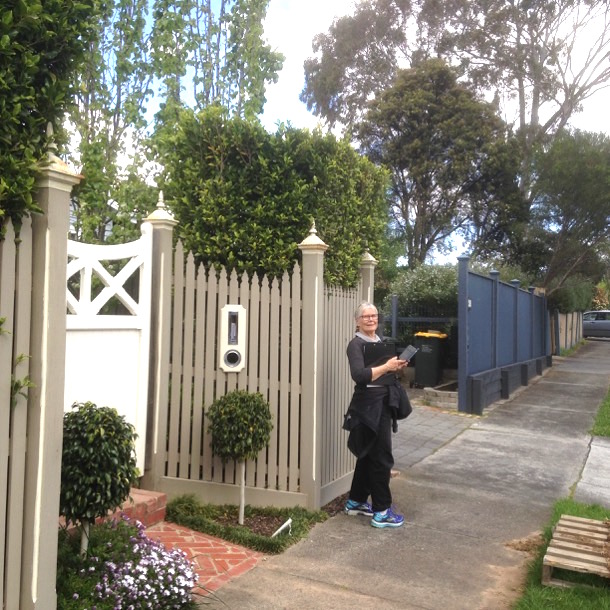
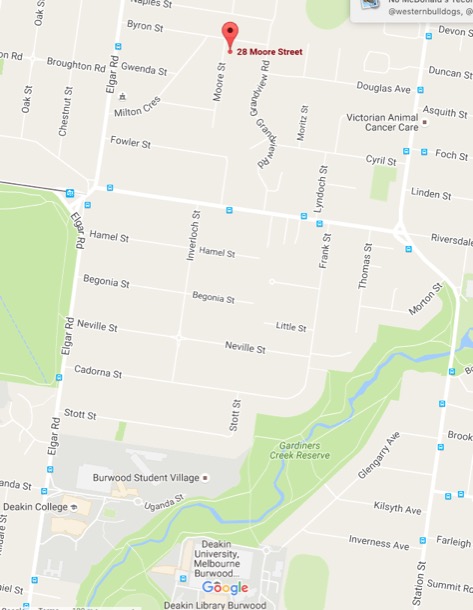
So now, sixty years later, we contemplated walking it again, those same roads and lanes, across that same creek. In our memories it was a long long way. “Are you up to it?”, Margaret texted Sue.
We park outside our old house in Moore Street and set off. And as we walk we remember:
Less than a minute into the walk, we round the corner into Grandview Road. To the west are the Dandenongs. The street trees are large and bright in their early Spring colours. It’s suburban, but well heeled and attractively quiet. We remark on a number of houses that seem unchanged. There’s the house where I babysat once, there’s another one where people from the church lived.

As we did this walk every school day, rain, hail or shine, we developed little rituals and markers, that now sixty years later we remember clearly. We often began our journey down Grandview Road, kicking a stone that we attempted to keep all the way to school. We don't think we ever succeeded.
Bright pink pig face flowers in spring marked the bottom of the hill. If the sun was out we always stopped and stared into the flowers for long enough for the world to turn green when we looked away. of course they are no longer there, but the rockery is.

“That’s the street to the Church just there! It’s so tiny! Everything is so close”
We have reached the bottom of Grandview Road in seemingly record time now the distances seem so small.
“I always liked this bit.”

Heading towards Riversdale Road, still in Grandview Road we relive our childhood pleasure in beautiful gardens and leafy streets.
Riversdale Road is quite a major road, but still not too busy. Across from the end of Grandview Road is the entrance to “the lane”.

It runs alongside the house that our church minister and family friend lived in. Behind their house were the church tennis courts. That whole property is now a collection of ugly units.The lane continues a long way down the hill toward the creek. At every cross road is an opportunity to go a different way through the grid of streets.
We walk along Neville Street and remark on the difference in this much lower socio economic area. Many of the old public housing houses are still there, unchanged from the nineteen fifties’ building boom. They are noticeable different in style from the “private “ housing and, as children, we knew that they were “housing commission” houses and that they were for poor people.

At the bottom of Stott Street we turn into yet another lane and at the other end we emerge into a green oasis.

Dogs are running free, chasing balls and each other, rolling in muddy puddles. Their young owners stand and chat. Up the hill a bit is a natural wood playground: slides, climbing frames, tasteful little forts. Further down the hill is a fenced off area of native bushland and, running through that the Gardiner's Creek. Well tended paths run along both sides of the creek and up to the adjoining streets. A noticeboard has a bird list and information about plans for improvement of the area. It is a pleasant Spring afternoon and Deakin students are strolling or jogging.
We conjure memories of how it was. This, the floodplain of Gardiner's Greek was the ‘wild’ section of the journey. The raised path, built by the fathers of the children who used this track daily, snaked its way across the grassed floodplain towards the bridge, also built by the fathers.

One old River Red-gum marked one of the bends in the path and large clumps of blackberries hid the creek from view. It was not the cherished indigenous community park it is now, but was a neglected wasteland. However it was interesting and often beautiful, especially in the morning. Sometimes we emerged from the lane to a white icy world, where spider webs hung between frosty grass stalks, glistening in the early morning sun. Sometimes the creek flooded. This was very exciting. We walked on the raised pathway, floodwaters on either side, wondering if the bridge was flooded. The water never covered the high bridge but the muddy torrent came very close.

On up the small hill past paling fences that belonged to cream brick houses we emerged on the school oval, the classrooms in the distance. Nowadays it is a multi story carpark.

Our little school has been completely swallowed by Deakin University, along with the Teachers College and our secondary school, Burwood High School. We walk onto campus, and there, in the middle of the glamorous uni buildings is a little row of ex classrooms. There on the end is where my Grade four room was, here's the breezeway. Up on the edge is the quadrangle where we practised marching. There was a breezeway along there and Mr Stafford's classroom.


We set off past the car park again, cross the creek and head back into the criss cross of familiar streets.
At the corner of Cadorna and Inverloch Streets we work out the place where “the accident” happened.

We remember it very differently of course: one of us watched in horror, the other was a participant. Here are our separate memories of it:
Sue:
Summer was a hot and dusty trek back across the creek after a full day at school. Once we had left the creek and started the climb up the hill in the hot suburban streets it was a bit of a slog. One such hot summer afternoon Margaret I were walking home with lan who was in Prep and the usual tribe of kids spread out across the two sides of the road. Margaret, seeing a friend on the other side of the road ran onto the road, straight into the path of an oncoming car. I don't remember much of the accident itself but I do remember a crowd of children and helpful women surrounding us as Margaret lay on the nature strip bloodied and battered with her head on my lap. The distraught young driver of the ute drove to get Mum (no mobiles) while we waited for the ambulance. Margaret disappeared with Mum into the back of an ambulance and Ian and I walked home.
Margaret:
I was nine, in Grade four. We were on the long walk home up the hill. Ian and Sue were there and lots of other kids. I ran across the road without looking, and was hit by a ute driving along Cadorna Street. It was a Friday.
After the accident I lay on the nature strip. “Ladies” from nearby houses tried to cover me with blankets, which I found irritating and pushed away. I remember Mum arriving and the ambulance. From my vantage point in the ambulance I remember seeing the corner of Riverside and Station Streets, as Mum told them they should be turning left not right.
At the Box Hill Hospital, I remember the decision of the doctor to pull out the tooth that was hanging loose. Two other teeth had been knocked right out, both of which had had gold fillings painfully inserted over the previous year, after an accident at gym.
At some stage there was a police interview. I remember Mum describing this process to someone else and laughing about the look on the Policeman’s face as he gently tried to coax information from me only to be presented with a dramatic and colourful description in far more detail than the poor man needed.
I remember coming home later that night. And then, possibly over the weekend, before I went back to school, I got mumps.
People bought presents: colouring books, a white china horse.
I guess the severity of the accident was exaggerated by the fact that I was laid up for weeks with mumps.
The sustained ongoing result of the accident was the absence of my three front teeth. Nowadays there would be counselling, PTSD and expensive restorative dental work.

After the accident reenactment we begin to walk up lnverloch Street. It is long, steep and dull. There are no leafy street trees and interesting gardens. It feels like a concrete jungle. We reminisce about hot afternoons trudging up here lugging our school cases. We turn right at the first cross street, relieved to be able to use the lane instead.

The lane takes us to the same place, the corner of Riversdale and Grandview roads, but it is much less steep. Soon we are crossing Riversdale Road and we remember the leafy cool shade of this part of the journey. It has seemed like a long way and we find ourselves trudging a bit up the hill.

The homeward journey has taken about an hour, including the accident reenactment, stopping to gaze at houses we remember and a conversation with a lady in Neville Street who was interested to know what we strangers were doing in her street, where she knew all her neighbours, “except the Chinese who keep to themselves”. It’s a pretty fair representation of what our trip home would have been like. School finished at 3.30. So we would have been turning into the Moore Street driveway about 4.30.


Lunchtimes at Primary School 1950s
23 09 15 17:07 Filed in: Children 1950s
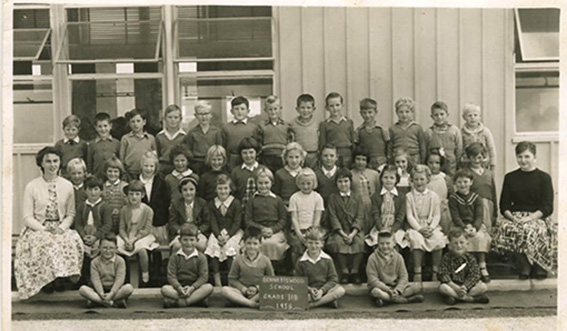
Both Sue and Margaret remember school games as going in crazes or fads. It was suddenly, as if by magic, swap card season. Nowadays you would explain a fad by noticing a particular advertising campaign, but that doesn’t account for the fads in the fifties and early sixties. Few people had television sets. No, clearly, it was magic!
Swap cards could be bought at the newsagent, and came in many special categories. (linens, pairs, “old fashioned”, horses).
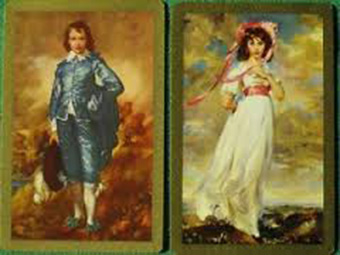
One had to know the value of particular kinds of cards in order to get a fair swap. Once a possible exchange had been agreed upon, each participant would leaf through her pack. This was closely watched by the other person who would ask the person to stop when a desirable candidate came into view. The process was then reversed to find a possible swap for it. Sometimes an exchange would take place, and sometimes not. Sue still has her swap cards.
Another season was hoops, made of cane.
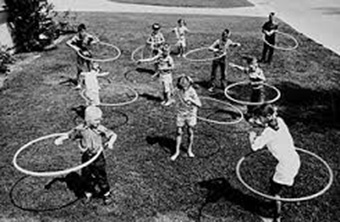
Scattered around the playground were individuals with gyrating hips, waists, necks, arms and legs. Neither Margaret nor Sue were very accomplished at it, but they participated, because that is what one did.
Another very individual fad was yo-yos.
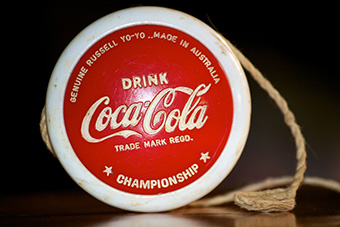
The best were coca cola ones, but there were others. Really clever people could do “around the world”, “walking the dog” etc.
Jacks, or knucklebones, which were actual joints of lambs they had eaten, were played in partners or groups. This was one of few games that we remember was played by both boys and girls.
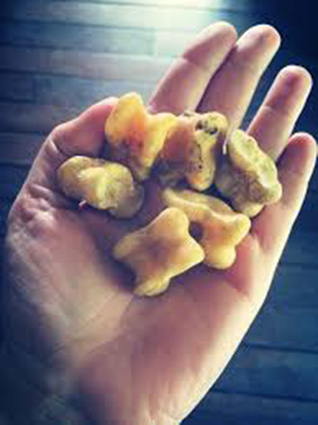
You had between one and five of them in your palm, and had to toss them up and catch them all on the back of your hand. We played this crouched or sitting on the ground.
The boys played alleys, or marbles.
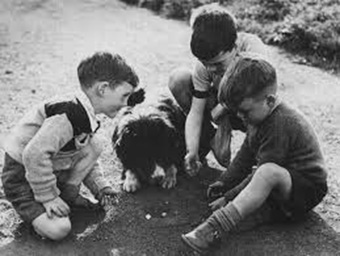

Marbles of different sorts had particular value. Bigger ones were called “tombollers”. There were cats eyes and other special ones. Playing involved risking your alley, as the winner of a game kept the loser’s alley. This didn’t seem to go in fads, presumably it was dependent on the weather, as it involved digging hollows in the dust. There was something called “dukes” involved. …. secret boys’ business. Alleys were kept in cloth bags, always home made.
Groups of girls did skipping.
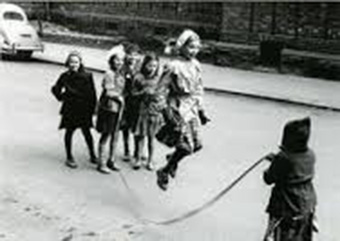
Presumably someone must have lugged a heavy rope to school for this. One person each end turned the rope and people would run in, timing their run with a skip and then jump until they missed and the heavy rope caught them on the leg. Margaret wasn't very good at this either, but Susan remembers her own skipping skills entirely differently. There were esoteric rhymes that went with skipping. Sue and Margaret both remember this one:
The big ship sailed on the Ally ally oh
The Ally ally oh, the Ally ally oh
The big ship sailed on the Ally ally oh
On the first day of September.
The captain said it would never never go
etc
Turns out it’s a traditional song, linked to the Manchester to Liverpool canal, which opened in the 1890s.
There was a shelter shed for each gender, for when it rained. It got packed then, but when it wasn’t raining you could play “pussy in the corner” which involved running across and jumping into the corners, up on the bench seats that ran around the inside walls.
Down the back of the oval were massive blackberry thickets. There were snakes and big rough boys there. Fights happened down there. Sometimes the boys built tunnels through the blackberries, through which brave people crawled, even girls. (Girls wore bare legs and dresses or skirts all year round.)
